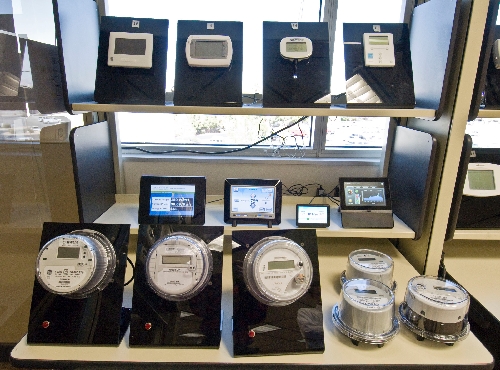Peak-pricing test will mean high bills for summer
Local summertime power bills could almost double under a peak-pricing trial that electric utility NV Energy has proposed, an expert told the state Public Utilities Commission on Wednesday.
Patrick Morton, an economist with the state Bureau of Consumer Protection, said his analysis of a peak-pricing experiment in California showed that August power invoices in Southern Nevada could surge from a 2009 average of $284.31 to an average of $531.02 under NV Energy's dynamic pricing trial. The trial would test whether charging more for power during peak or high-use periods would alter electric consumption.
Senior citizens and low-income households would be especially vulnerable to the higher prices because they're less likely to be able to shift energy use away from summertime peaks between 3 and 7 p.m., Morton said.
NV Energy would charge much lower rates in off-peak winter periods, so the average annual power bill would actually decline, from $1,897.12 in 2009 to $1,804.78 during the trial.
Still, Morton questioned some consumers' ability to take advantage of energy-conservation measures, and he said savings could evaporate over the long term if ratepayers don't sustain their efficiency efforts.
NV Energy's suggested energy-management tools include e-mail alerts and Internet programs to guide ratepayers on power use. But 24 percent of locals lack computer access, Morton noted.
"A lot of these tools and interfaces seem to be geared to people with higher incomes with higher usage they can switch (to off-peak hours)," Morton said. "Obviously, whenever you change something, you have winners and losers. What's important is to look at the subset of population that's being affected."
The pricing test would come courtesy of Advanced Service Delivery, a digital-meter initiative that NV Energy is asking the Public Utilities Commission to approve. The commission is holding hearings this week to gather details on Advanced Service Delivery's pros and cons.
NV Energy executives estimate that Advanced Service Delivery would save the utility $35.6 million a year in operating costs. The company has $138 million in federal stimulus funds to help finance the $301 million program's rollout. The remainder of funding could eventually come from higher power rates if the Public Utilities Commission approves the system.
Advanced Service Delivery would make peak pricing possible because the system's "smart" meters would let consumers and the utility track power use on an hourly and daily basis.
NV Energy officials testified Tuesday that a two-year peak-pricing study beginning in January 2012 would let the company gauge whether variable power expenses might encourage consumers to conserve electricity during high-use periods. Their contention: Pushing some of the power load to off-peak times would help spare the company from expensive spot-market power buys, and it would curb the need for ratepayer-funded investments in new generating plants.
Participation in the pricing pilot would be optional. NV Energy would guarantee equal or lower power bills for the first year for ratepayers who opt into the test, and participants could opt out of the trial after a year. The utility hopes to get 18,000 ratepayers to sign up for the test.
The commission will hear a separate case in late 2010 detailing the specific rates that would apply under dynamic pricing.
But consumer advocates said Wednesday that the idea of peak pricing concerns them.
Morton fretted over "incrementalism," or the possibility that the pilot program could change over time from a small, voluntary test to a larger, mandatory billing regime. Morton also questioned ratepayers' ability to alter long-term energy use.
Consider the adoption of programmable thermostats "as an example of laziness trumping logic," he said. Just a third of Americans own the thermostats, and fewer than a fifth of those owners use the devices to change their home's temperature when they're gone. And, an analysis of nearly 20 pricing studies nationwide found that time-of-use rates in some studies were ineffective at sustaining new consumer behaviors.
"Our concern is, after two years, what happens? When people start on a program, they're eager to change habits," Morton said. "It's like a race. You start out very fast, but you lose your interest and energy. What's of concern is changing long-term behavior."
Under questioning from NV Energy's attorneys, Morton did acknowledge that California's experiment with peak pricing showed that ratepayers would change consumption patterns if given an economic incentive.
Richard Trachok, a Jones Vargas attorney who's representing NV Energy before the commission, noted that the California pilot program showed a decrease in overall power bills.
Trachok added that consumers in that trial increased their off-peak power use by the same amounts they cut consumption in peak hours.
Asked Trachok: "Isn't that the goal of demand-response" programs such as dynamic pricing?
Morton agreed, but said overall energy use "basically ends up pretty much flat," with simple shifts in use rather than actual conservation.
Another Bureau of Consumer Protection witness questioned NV Energy's plan to boost collections through Advanced Service Delivery.
The utility has a written policy of disconnecting consumers who fall $75 behind on their bills, but labor shortages mean the company doesn't actually disconnect until a customer is $100 in arrears. Smart meters would come with a remote-cutoff function that would let the company enforce its $75 threshold. The result would be a gain of 20,000 additional nonpayment shutoffs annually.
Boston consultant Nancy Brockway testified that the utility should keep its $100 limit in place.
"Tightening up on disconnection as a means of collection for credit management is counterindicated by the difficulty of the economic situation in Nevada right now," Brockway said. "This would be the time to work more with customers. Maybe in the short term, the company might suffer certain bad debt, though that's not proven. But in the long term, you'll have a healthier community and a healthier company."
The Public Utilities Commission will make a decision on Advanced Service Delivery by July 28.
Contact reporter Jennifer Robison at jrobison@review journal.com or 702-380-4512.


















